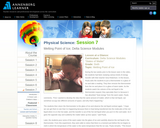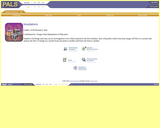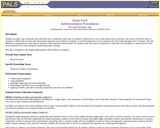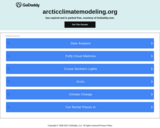
This resource is a video that accompanies the lesson plan, "Heat, Temperature and Conduction."
- Subject:
- Science
- Material Type:
- Lesson
- Provider:
- American Chemical Society
- Author:
- Patti Galvan and Jim Kessler
- Date Added:
- 02/26/2019

This resource is a video that accompanies the lesson plan, "Heat, Temperature and Conduction."

This resource is a video that accompanies the lesson plan, "Heat, Temperature and Conduction."

Students complete an activity in which heat is transferred from hot water to metal washers and then from hot metal washers to water.

This resource is a video that accompanies the lesson plan, "Heat, Temperature and Conduction."

This video demonstrates the difference between heat and temperature and examines how both are defined in terms of particles. It illustrates the transfer of heat energy and uses a particle model to explain a number of everyday phenomena, including why things expand when they are heated to the role that temperature plays in changes of states of matter.

In this lesson, students apply the concepts of conduction, convection and radiation as they work in teams to solve two challenges. One problem requires that they maintain the warm temperature of one soda can filled with water at approximately human body temperature, and the other problem is to cause an identical soda can of warm water to cool as much as possible during the same 30-minute time period. Students design their engineering solutions using only common everyday materials, and test their devices by recording the water temperatures in their two soda cans every five minutes.

In this lesson, students test a variety of insulators and relate their knowledge to energy conservation. With teacher guidance, students design their own investigation. After all experiments are completed, the class looks across the data and draws evidence-based conclusions.

Assess students' understanding of scientific inquiry including the following skills: observation, background research, scientific procedures (including investigation design, measurement techniques, and error analysis), data collection, data display, scientific questions, formulating an hypothesis. Students will design and carry out an investigation to test which material is the best insulator; they will predict which way heat energy will flow in a system and analyze the flow of energy in a system from one point to another and from one form to another.

This is a lesson about the technology as it relates to heat transfer (conduction and convection)on the International Space Station. Learners will investigate how to build a space suit that keeps astronauts cool. This is technology activity 1 of 2 found in the ISS L.A.B.S. Educator Resource Guide.

This is a lesson about the robotic arm on the International Space Station. Learners will build a robotic arm to grapple (grab onto) a spacecraft and then use it to grapple different classroom objects. This is technology activity 2 of 2 found in the ISS L.A.B.S. Educator Resource Guide.

In this activity, students investigate convection by using food coloring and water of different temperatures.

While investigating heat transfer by conduction, students will make decisions about appropriate approaches and methods for gathering specific information.

In this lesson, students will conduct an investigation in which they will infer the flow of heat between a container of hot water and a container of cold water.

In this lesson, students will explore the various types of electromagnetic radiation with the use of a sorting activity. Students will then create a model to represent the EM spectrum, including the names of the parts of the spectrum and the uses and applications of each frequency of the spectrum.

Students test paper cups, styrofoam cups, and metal cans to determine which type of container would be best to use to keep drinks cool on a hot day. Each type is filled with ice water and temperature is recorded at specific time intervals.

In this activity, students explore insulation and heat transfer by designing and testing a soda insulator.

Students will investigate how temperature affects molecules and relate it to the science of Chinook winds, microbursts, and hurricanes.

In this lesson, students are presented with a formative assessment probe, The Mitten Problem, to elicit ideas about sources of heat. Students design and conduct a follow up investigation to further explore their developing ideas about heat.

In this lesson, students design and carry out an investigation to monitor the temperature of water when equal volumes of hot and cold water are mixed.

In this lesson, students expand their understanding of thermal energy transfers by focusing on the directionality of heat transfers. Students collect temperature data from two interacting containers of water and from their results infer that heat is transferred from warmer matter to cooler matter until both substances reach the same temperature.